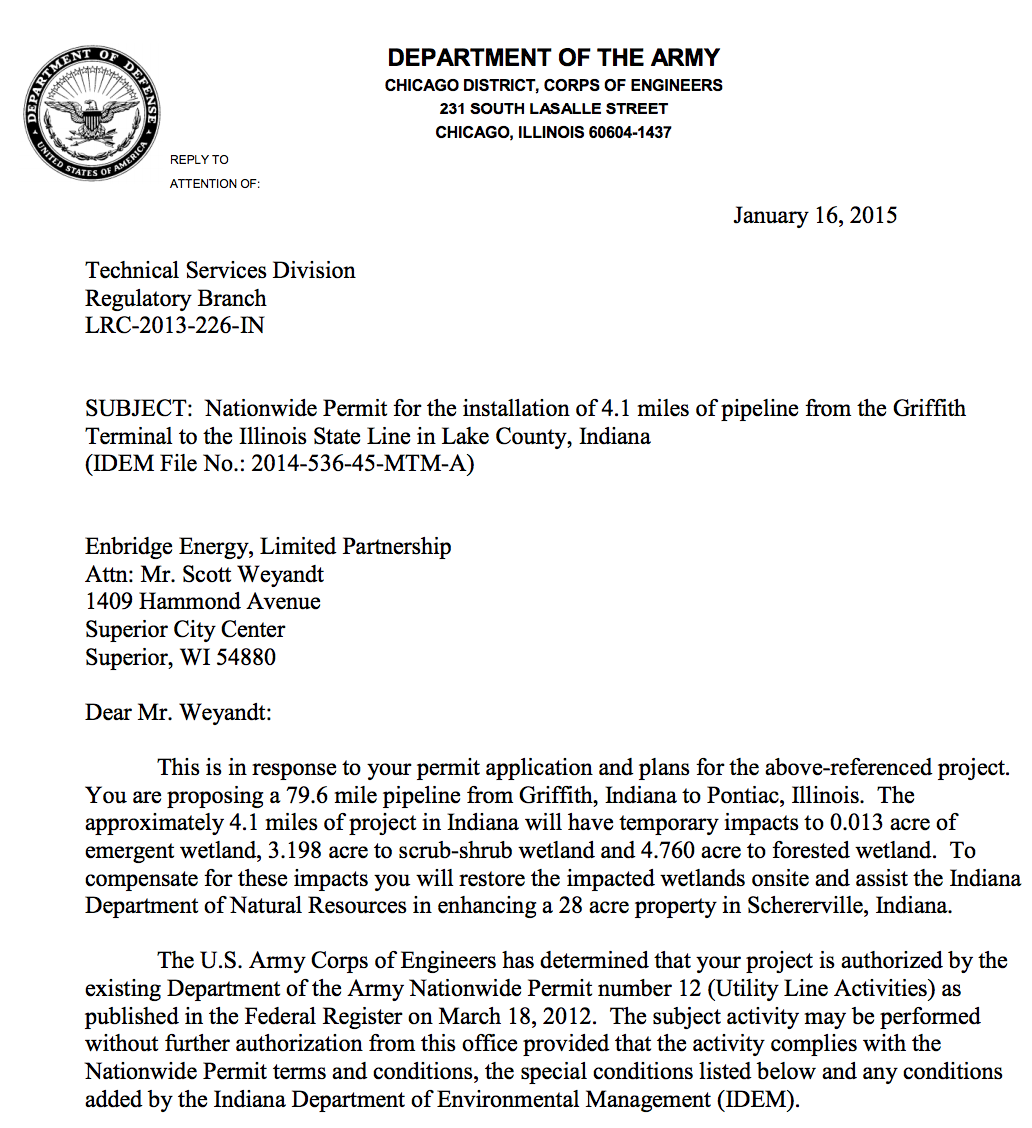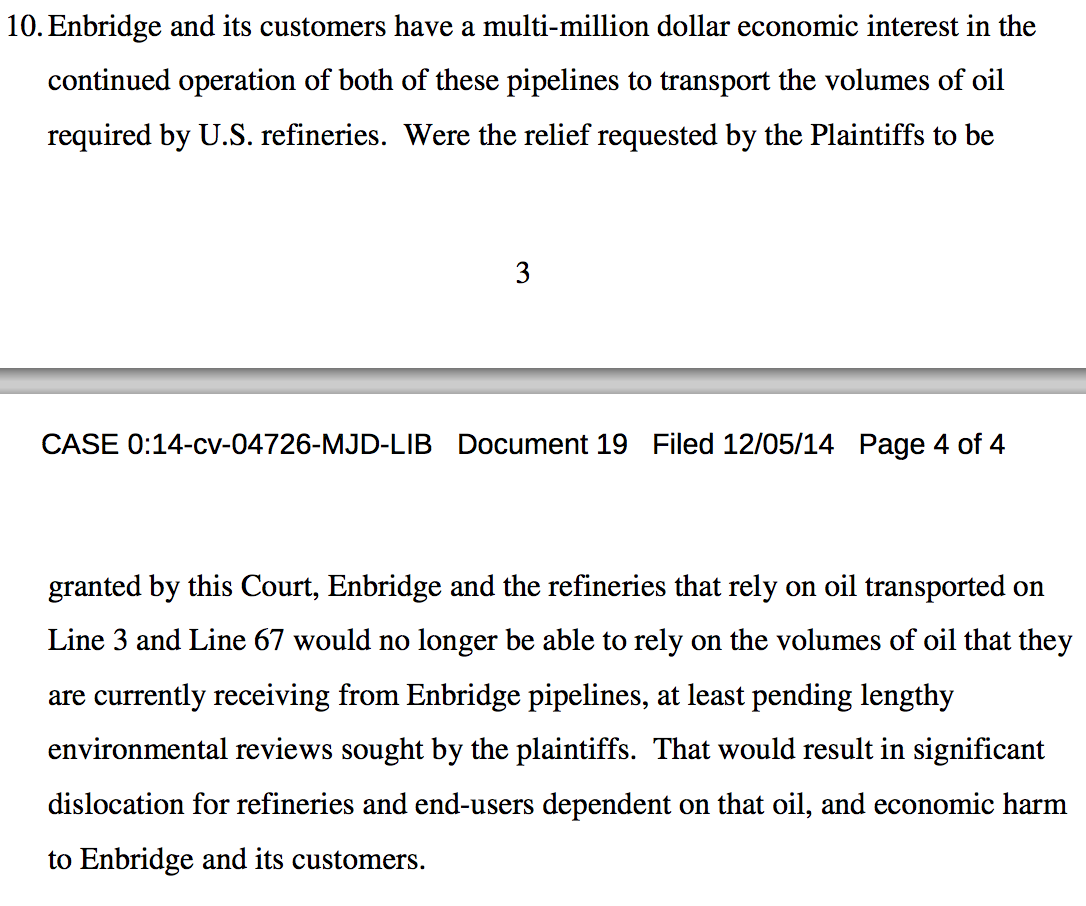On January 16, the U.S. Army Corps of Engineers gave Enbridge a controversial Nationwide Permit 12 green-light for its proposed Line 78 pipeline, set to bring heavy tar sands diluted bitumen (“dilbit”) from Pontiac, Illinois to its Griffith, Indiana holding terminal.
The permit for the pipeline with the capacity to carry 800,000 barrels-per-day of tar sands dilbit came ten days after the introduction of S.1 — the Keystone XL Pipeline Act — currently up for debate on the U.S. Senate floor, which calls for the permitting of the northern leg of TransCanada’s Keystone XL.
Griffith is located just south of Whiting, Indiana, home of a massive refinery owned by BP. In November 2013, BP opened its Whiting Modernization Project, which retooled to refine up to 85-percent of its capacity as heavy dilbit from the tar sands, up from its initial 20-percent capacity.
Legal Challenge
In July 2014, environmental groups including the Sierra Club, National Wildlife Federation, Center for Biological Diversity and Environmental Law and Policy Center submitted a letter to the Army Corps, requesting a full National Environmental Policy Act (NEPA) review for Enbridge’s proposal.
As with TransCanada’s Keystone XL southern leg, Enbridge’s Flanagan South and Enbridge’s Alberta Clipper expansion, Enbridge dodged a more democratic and transparent NEPA review from the U.S. Environmental Protection Agency and other executive agencies.
“Once again, the Corps has improperly segmented its approval of an Enbridge tar sands pipeline so as to avoid evaluating the project’s true environmental impacts or the impacts of the ongoing expansion of the Enbridge system,” Doug Hayes, staff attorney for the Sierra Club, told DeSmogBlog.
TransCanada Energy East Clone
Just as DeSmogBlog has called Enbridge’s north-to-south dilbit pipeline network a “Keystone XL Clone,” Enbridge has quietly proposed and is currently permitting into existence a clone of TransCanada‘s controversial Energy East dilbit pipeline.
According to the map of Line 78 on Enbridge’s website, the pipeline will connect with Line 6B in Griffith. Line 6B is infamous for the biggest dilbit pipeline spill in U.S. history. Taking place in Kalamazoo, Michigan, environmental activists and advocates now refer to the 1 million+ barrel spill as the “dilbit disaster.”
Line 6B will then connect with Enbridge’s proposed Line 9 Reversal project (also known as the Eastern Canadian Refinery Access Initiative), which will bring tar sands dilbit to Canada’s east coast — like Energy East — for potential export.
Declaration of Money
Sierra Club, National Wildlife Federation and the Center for Biological Diversity, 350 Minnesota, Honor the Earth, Indigenous Environmental Network and others also sued the U.S. State Department on November 12 in an ongoing lawsuit for what they say was a violation of NEPA with regards to the State Department’s covert approval of the Alberta Clipper expansion project.
Enbridge requested to enter the case as an intervenor and the magistrate judge for the case recently accepted the request. Enbridge and the State Department have until January 30 to respond to the initial legal complaint.
As perhaps a foreshadowing of things to come, Robert Kratsch — a manager of design and construction for Enbridge and the lead point of contact for the Alberta Clipper expansion proposal — submitted a crucial legal memo in support of Enbridge’s intervention on December 5.
In so doing, Kratsch echoed the judge’s ruling in the NEPA lawsuit filed by environmental groups against the Army Corps of Engineers as it pertains to Keystone XL South.
After spending nine paragraphs explaining what the pipeline is and does, Kratsch delivered his knock-out blow, stating that nullifying the Alberta Clipper expansion project would put a damper on the company’s potential corporate profits.
Image Credit: U.S. District Court, District of Minnesota
Judge Ketanji Brown Jackson, an Obama appointee, agreed with this line of argument by TransCanada for Keystone XL South. Will Judge Michael J. Davis, a Bill Clinton appointee and designated judge for the Alberta Clipper expansion legal dispute, do the same?
With the Alberta Clipper expansion pipeline legal dispute ongoing and a legal challenge to Line 78 highly possible, one thing remains certain: if the past serves as prologue, corporate profits earned and potential loses will serve as the centerpiece for Enbridge’s legal argument going forward.
And as a recent article written by Boston College Law School professor Kent Greenfield (author of the book ”The Failure of Corporate Law: Fundamental Flaws and Progressive Possibilities”) explains, these dynamics have played out for almost a century.
“The eventual decision was, and still stands for, an iconic statement that corporations have no obligations beyond the bottom line,” Greenfield wrote in pointing to the landmark 1919 Dodge v. Ford Motor Co. decision handed down by the Michigan Supreme Court. “Courts, then and now…did not, and still do not, typically overturn the considered decisions of corporate managers.”
Image Credit: Imilian | Shutterstock
Subscribe to our newsletter
Stay up to date with DeSmog news and alerts








